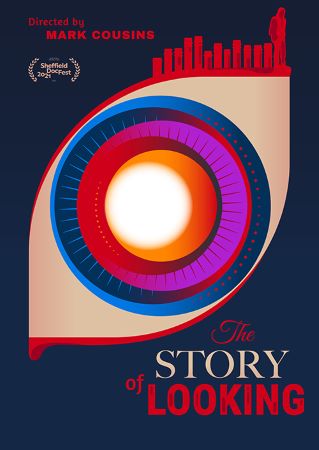
The Story of Looking 2021
Distributed by Docuseek2
Produced by Mary Bell and Adam Dawtrey
Directed by Mark Cousins
Streaming, 87 mins
General Adult
Art; Documentaries
Date Entered: 09/26/2023
Reviewed by Audra M. Deemer, Head of Acquisitions & Collections, DePaul UniversityThe day before filmmaker Mark Cousins has eye surgery to potentially save his eyesight, he takes us on both a personal and a universal rumination on the visual experience of living in the world.
Cousins explores “a lifetime of looking” and the joy of that looking through art, film, and his own life and work. The images presented are often striking and thought provoking, while some are also mundane, as he narrates and traces the journey of seeing from birth to old age, through colors, light, how we see ourselves, and the likely and unlikely visual connections we make.
To foreshadow his own surgery, probably not surprising to most who have ever studied film, is the inclusion of the eye slicing clip from the opening of Buñuel’s Un Chien Andalou (1929). We later see Cousins’ eye surgery which squeamish viewers may have trouble watching as well. While maybe not easy to watch, it makes sense for him to include it here as someone who seems to be compelled to document everything.
There is some consideration of the obvious connection between looking and voyeurism, as well as the exhibitionism of some being looked at. Cousins spends much of the film shirtless and even showing his full-frontal nude self, asking the viewer if this makes him an exhibitionist or us voyeurs. But unfortunately, nothing much is explored here, just simply a question posed to the viewer to consider. There is also no discussion of how gender politics may affect the difference in experiences of women objectified by the voyeur and the male gaze. It seems like an obvious opportunity to explore, but it’s almost as if he has never considered this.
Another missed opportunity of Cousins was to consider how people living with visual impairments may experience “looking.” Cousins briefly discusses talking with a woman who has colorblindness and inspired him to watch The Wizard of Oz (1939) in black and white. But this is as far as he goes to consider experiences outside of his own.
Since much of Cousins’ presence in the film is him lying in his bed and at one point reading tweets in response to a question he posed about people’s own visual lives, there is a bit of self-indulgence. This may be off-putting for some viewers. At the same time, this is his story of looking, so the self-indulgence is maybe not surprising (and this was filmed during a COVID-19 lockdown). It is also the experience of someone who works in a highly visual medium and is potentially going to lose their sight. It must be a disquieting ordeal for him.
This film could be useful for students in the visual arts including film and photography, but also could be of interest to writers, poets, and storytellers, as well as general interest for those who enjoy highly visual documentaries. This is recommended with reservation as this is just one man’s story of looking, presented through an idiosyncratic and somewhat indulgent lens.
Awards:Seville European FF, Best Film – Non Fiction
Published and licensed under the Creative Commons Attribution 4.0 license. Anyone can use these reviews, so long as they comply with the terms of the license.